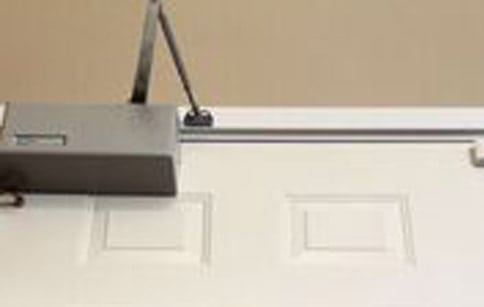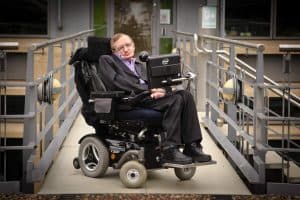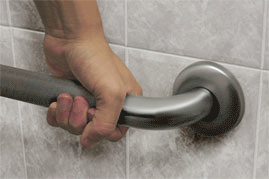The earliest records of wheeled furniture are an inscription found on a stone slate in China and a child’s bed depicted in a frieze on a Greek vase, both dating to the 5th century BC. The first records of wheeled seats being used for transporting disabled people date to three centuries later in China. The invalid carriage or Bath Chair brought the technology into more common use from around 1760. In 1887, wheelchairs (“rolling chairs”) were introduced in Atlantic City so invalid tourists could rent them to enjoy the Boardwalk.
In 1933 Harry Jennings and his disabled friend, Herbert Everest, both mechanical engineers, invented the first lightweight, steel, collapsible wheelchair. Everest and Jennings saw the business potential of the invention and went on to become the first mass-market manufacturers of wheelchairs. Their “x-brace” design is still in common use, albeit with updated materials and other improvements.

Today, there are a wide variety of types of wheelchair, differing by propulsion method, mechanisms of control, and technology used. Some wheelchairs are designed for general everyday use, others for single activities, or to address specific access needs. Lately, wheelchairs have morphed more into ‘personal mobility vehicles’ for disabled people who want to do more in their lives or have particular mobility challenges.
Here are some of the latest, innovative wheelchair designs whose purpose is to take personal mobility for the disabled to the next level:
• The PUMA (Personal Urban Mobility and Accessibility) applies the same technology as the famous segway personal transportation vehicle, which requires the rider to stand. Two self-balancing electric motor wheels, as well as a specialized gyroscope, keep everything steady. The PUMA is powered by lithium batteries and can cover up to 35 miles on one charge.
• The CARRIER wheelchair was specially designed to achieve maximum user independence and to travel over all types of terrains, including stairs. Another advantage is that the design allows users to go to the toilet without getting off the chair, thus saving them the trouble of having to lift themselves off to move to the toilet and back each time.
• The WISB hand-bike is a concept developed as a cross between a wheelchair and a sports bike, giving the users the option of choosing between an indoor ‘low’ mode and an outdoors ‘high’ mode for longer distances.
• Japanese designer Mauricio Maeda’s wheelchair includes a computer case under the seat, a joystick for movement, a track ball, keyboard, monitor, speakers, wireless headset, a webcam, a drink holder, a stereo sound device behind the seat, a power source on back, and a remote control.
• The MOUNTAIN TRIKE is an all terrain wheelchair that allows users to venture out into the countryside.
• The ROTA mobility chair is actuality a human-powered scooter that can be moved (or ‘rowed’) by using a central lever.
• The TANK CHAIR is a specialized wheelchair for all terrains. It can cross streams, and drive on sand, snow, or mud.
• The TANDEM is perhaps the only wheelchair that was designed to give someone else a ride.This design aims to remove the stigma of a wheelchair user as someone who requires help, and instead gives the user the power of being the one giving the help.
• The CURSUM STROLLER for wheelchair users allows handicapped parents to still take their baby out for strolls.
In addition, there are some new concept, robotic wheelchairs now being developed by teams of students and researchers. They include:
• A solar-powered wheelchair that has a retractable roof with solar panels embedded on top of it has been designed by students from University of Virginia’s School of Engineering and Applied Science.
• A team led by Shuro Nakajima at the Chiba Institute of Technology has created a robotic wheelchair that can climb up or descend down the stairs, and make 360 turns for ultra-mobility in tight spaces.
• Researchers at the Federal Institute of Technology in Lausanne have developed a brain-controlled, robotic wheelchair that uses shared control to navigate. The rider’s brain signals are translated into commands and this moves the wheelchair in the desired direction without even moving the hands.
• Engineers at the Georgia Institute of Technology have developed an assistive technology called the Tongue Drive system. It requires the implanting of small magnets, the size of a rice grain, into the rider’s tongue. The movement of the tongue is detected by an array of magnetic field sensors mounted on a headset outside the mouth or on an orthodontic brace inside the mouth, which then directs the chair’s movements.
Wheelchair design continues to evolve, making life easier and more enjoyable for wheelchair users. At Pacific Mobility, we can give you all of the specifics and help you decide if a new wheelchair is right for you. Call us, today, or visit us, for a free consultation.
President, Husband, Father, Grandfather Graduate of UC Davis- Bio Sci Major- Go Aggies! Jeff has extensive experience in all of Pacific Mobility’s products and services, and specializes in accessibility products as well as stairlifts, ceiling lifts and custom wheel chairs. His hobbies include spending time with family, gardening, mountain biking, exercising and off road motorcycle riding.
24 years as Owner/President of Pacific Mobility Center – selling, installing, and servicing stairlifts, porch lifts, ceiling lifts, pool lifts, handicap ramping, specialty wheelchairs, scooters, power wheel chairs, and other power mobility devices
Certified Environmental Access Consultant since 2008
Licensed General Contractor since 1998
Certified Aging in Place Specialist since 2016
Board Member for Home Access Professionals
Member of Association of Members of the Accessibility Equipment Industry (AEMA)





 Three basic power lift chair styles are the two-position chair, the three-position chair, and the infinite position chair. The two-position lift chair is built to recline as much as 45 degrees. It is designed for the casual user and is not ideal for napping, or prolonged periods of sitting. The three-position lift chair reclines to an almost flat angle, which more closely mimics the range of a standard recliner. It is a better alternative for those who intend to nap while in it. The infinite-position lift chair is the most expensive type, but a good choice for a person who will be spending a lot of time sitting or lying in it. It generally offers more comfort and therapeutic options, such as dual motors which allow the footrest and the seat back to move independently, and a greater range and combination of positions. Typically the infinite position chairs all user to lay in Trendelenburg Position (heart below lower extremities) which is very helpful in eliminating swelling in the legs.
Three basic power lift chair styles are the two-position chair, the three-position chair, and the infinite position chair. The two-position lift chair is built to recline as much as 45 degrees. It is designed for the casual user and is not ideal for napping, or prolonged periods of sitting. The three-position lift chair reclines to an almost flat angle, which more closely mimics the range of a standard recliner. It is a better alternative for those who intend to nap while in it. The infinite-position lift chair is the most expensive type, but a good choice for a person who will be spending a lot of time sitting or lying in it. It generally offers more comfort and therapeutic options, such as dual motors which allow the footrest and the seat back to move independently, and a greater range and combination of positions. Typically the infinite position chairs all user to lay in Trendelenburg Position (heart below lower extremities) which is very helpful in eliminating swelling in the legs.


